Flat roofing materials differ significantly from those used for pitched roofs. Popular asphalt shingles, cedar shakes or steel sheets are unlikely to perform well as a flat roofing material. That’s why membranes are used, such as PVC, TPO and the one we’ll look at today, EPDM coatings.
Table of Contents
Why Do Flat Roofs Need a Membrane?
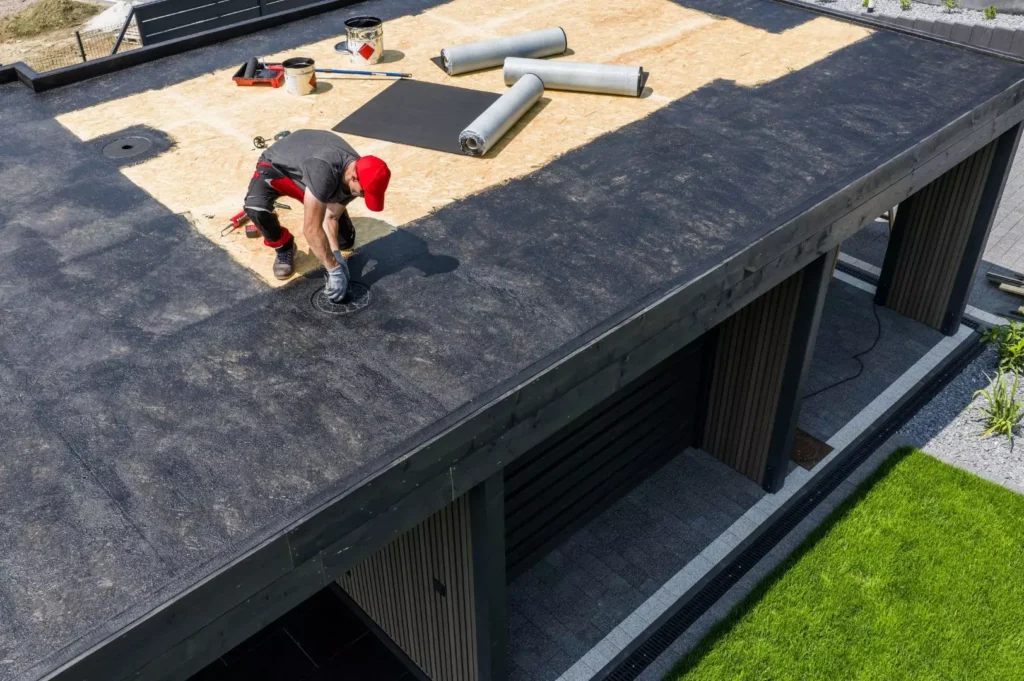
The difference between pitched and flat roofing materials is due to their different construction and demands. While asphalt shingles, forming a layered structure that drains water and snow well, are great for a sloping roof, installing them on a flat roof would be a very bad idea – it would lead to water ponding and the rapid development of leaks. It is the ponding of water and other things on a flat roof that is the biggest threat here that the roofing has to face.
This is precisely what roofing membranes are used for, and they need to be fully airtight and waterproof, and even more resistant to various weather conditions than other roofing materials (for example, those of pitched roofs). The material must be strong enough to withstand snow that stays on the roof for weeks. Under such a stress, not airtight material would definitely fail.
Of course, this doesn’t mean that there can’t be enough snow to remove. Even the best construction with a high-quality membrane will not be able to handle the appropriate amount of heavy material exerting pressure on it. Therefore, it is important to remember that such situations are not a consequence of poorly chosen roofing – no roof can withstand adequate amounts of snow, so if the weather is exceptionally unfavorable, you have to deal with it manually.
What Is An EPDM Membrane?
EPDM membrane (ethylene propylene diene monomer) is a single-layer roofing material made of synthetic rubber, which is enriched with various additives such as carbon black, oils and hardeners to give it the highest possible strength. The material undergoes a vulcanization process, which means it is combined with sulfur and exposed to very high temperatures. The EPDM rubber is then cured and gains many key properties, such as resistance to deformation, UV, ozone, frost and high temperatures.
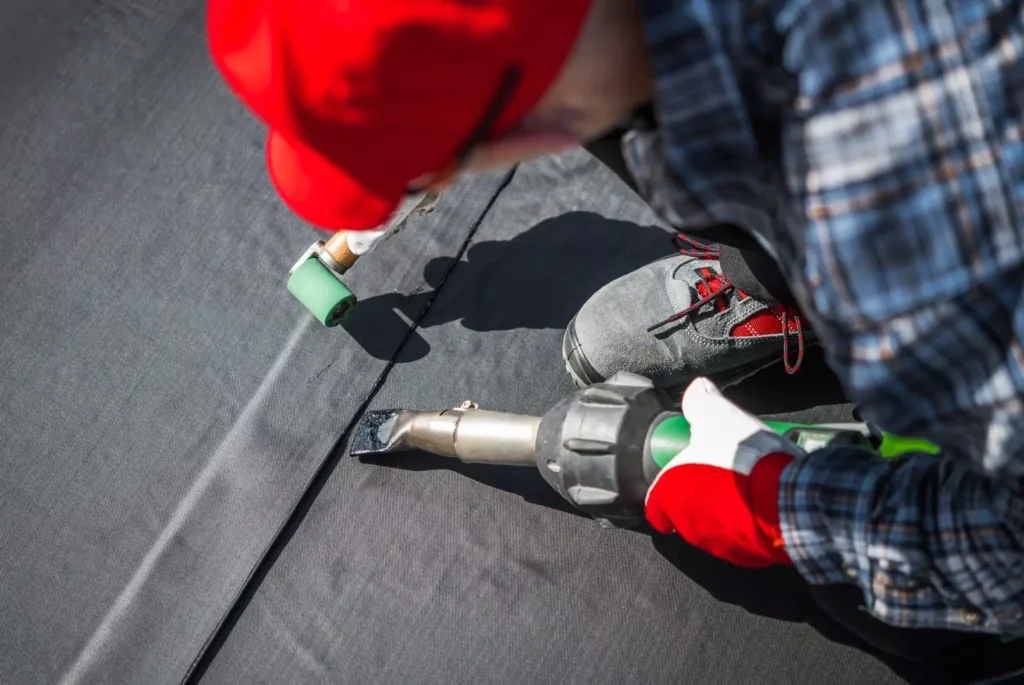
EPDM Roofing Installation Process
For the future of the roof, the installation process itself is very important. As with most roofing materials, if the material is installed incorrectly, it will be more prone to unwanted problems in the future. Remember to use an experienced and certified contractor when installing roofing.
EPDM roofing material is sold in the form of large rolls, which are later rolled out on the roof. The EPDM sheets are left for about 30 to 45 minutes to allow them to straighten out and lay properly, and then trimmed in the appropriate places so that they are ready to join together and cover the entire roof surface precisely. Next comes fastening, meaning the membrane is fused to the roof. There are 3 methods:
- The most commonly chosen is the Full Adhesive System (FAS). In this case, the EPDM membrane is glued to the roof over its entire surface using contact adhesive. This method is particularly suitable for irregularly shaped roofs, where the greatest precision must be maintained regarding trimming and gluing. It is also desirable in cases where the roof contains numerous architectural details (such as skylights, hatches, chimneys);
- Another method is mechanical fastening, using, for example, fastening plates or screws to the roof substrate. This solution is chosen more often for large, industrial roofs with simple shapes. The big advantage of mechanical fastening is that it allows quick installation and removal, which finds its application in temporary facilities (e.g., tent halls, seasonal warehouses);
- The last method of fixing EPDM is the ballast method. This solution has one unique feature – the membrane is not physically attached to the roof. By this fact, the decision to choose a ballast system must be well thought out. This method works well on roofs where a pressure layer is provided, for example, concrete slabs, green roofs or terraces. When installing EPDM using the ballast method, it is important to remember that the roof structure must be strong enough (to withstand the pressure) and the ballast properly distributed to prevent wind damage.
As you can see, the methods are different, but each of them has one basic fact in common – a poorly executed installation prevents long-term enjoyment of the full capabilities of the EPDM membrane. It should also be carried out under proper conditions – avoiding moisture is especially desirable here.
After fixing, the sheets are joined by applying primer to their edges and mounting tape in the middle. Such joints ensure durable construction and resistance to various weather conditions. After joining the sheets, all that remains is to protect the details, i.e. special treatments of the material in places that require it (roof edges, drainage holes).
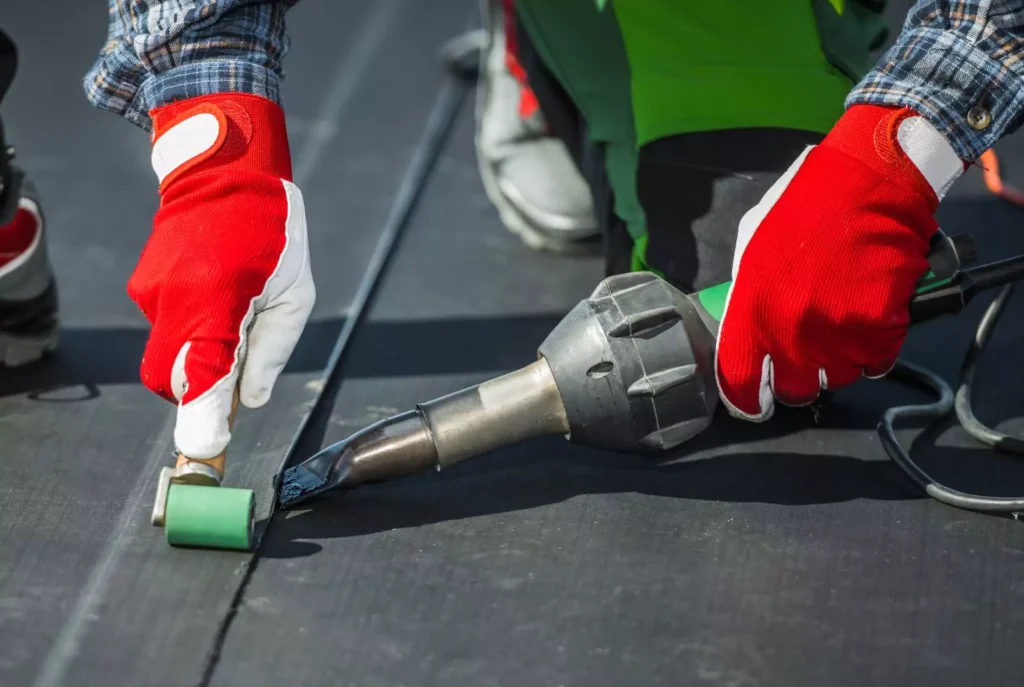
How Long Do EPDM Roofs Last?
EPDM membrane boasts the best durability among other membranes available on the market. It owes this to certain properties that arise from the structure of the material. A major advantage of EPDM is its extensibility and flexibility. The material can stretch up to 300% of its surface without losing its tightness and resistance to cracking, even at extreme temperatures (even -49°F!). This allows the material to move with all the building structure, reducing the risk of cracking.
EPDM roofing system is also extremely resistant to external conditions, i.e. temperature fluctuations, UV radiation, rain, frost, snow, but also to chemicals and corrosion, which makes it perform well on industrial buildings. If properly installed and maintained, it can perform its function for up to 60 years. This is a very good result, especially since its competitors last much less:
- TPO – typically 20-30 years, with a maximum of 35, with premium products and very good maintenance;
- PVC – usually 25-35 years, up to 40 at times, with high-end products and proper care.
- Modified bitumen – 15-30 years.
How Much Does EPDM Rubber Cost?
EPDM flat roof membrane with a thickness of 3/16″ usually costs from about $3 to $6 per sqft. This is significantly more than asphalt shingles (about $2 per sqft), but less compared to other membranes such as TPO or PVC, for example. EPDM is therefore considered a relatively inexpensive material, which can be important for buildings with large roof areas, such as factories or warehouses.
In addition to the cost of purchasing the membrane, you have to factor in labor costs. These, in turn, are not very different from the price of installing TPO or PVC, since they are comparable processes. In sum, the installation of 1 square of EPDM rubber roof usually costs between $700 and $1,000, unless additional holes, seals or flashing installation is required.
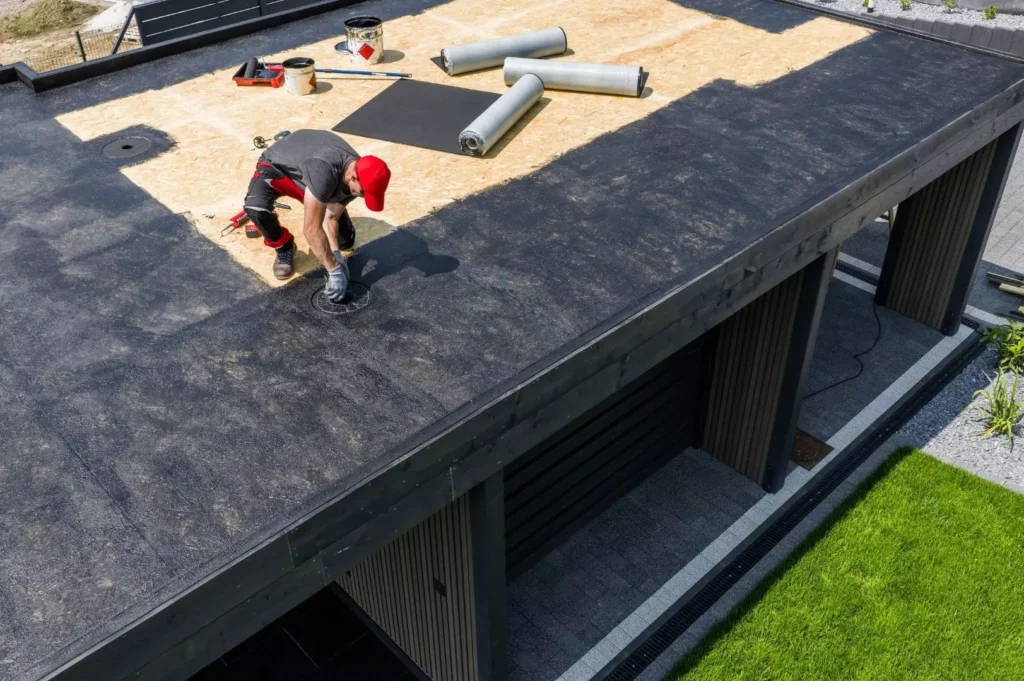
EPDM Roof Maintenance
Just like any other roof, one covered with an EPDM membrane requires proper maintenance. Maintaining this roof means regularly checking for cracks, tears, or damage. Focus mainly on vulnerable spots, such as edges, sheet joints, corners, etc. – that’s where damage is more likely to appear. Inspecting the roof once a year is completely sufficient. Remember that a universal rule when taking care of the roof, is that the earlier the problem is detected, the cheaper and faster it will be to repair it.
Along with the inspection, washing the roof each year is recommended. This mainly involves cleaning it of unwanted materials, such as branches or dust. You can use pressurized water for this. In addition, it’s a good idea to wash the material with a mild detergent for EPDM membranes – it’s better to avoid highly corrosive solvents, as they can have a bad effect on the life of the roof.
Is EPDM Environmentally Friendly?
The good news is EPDM roof membrane has virtually all the properties that a material should have to claim that it is ecological. First, EPDM does not emit any harmful chemicals – the water that runs off it can later be safely used for, for example, watering the garden. After the material wears out, which occurs after many years (often twice as many years as other coverings), it can be recycled, so even after it is used up it does not pose a burden on the environment. The environmental appeal of EPDM is added by the fact that its production has a very low carbon footprint, or CO2 emissions.
Adding all these aspects together, it comes out that the material that makes up an EPDM roof coating is environmentally friendly during its entire life cycle – from production, through the long life of the roof owner, to recycling and new life.
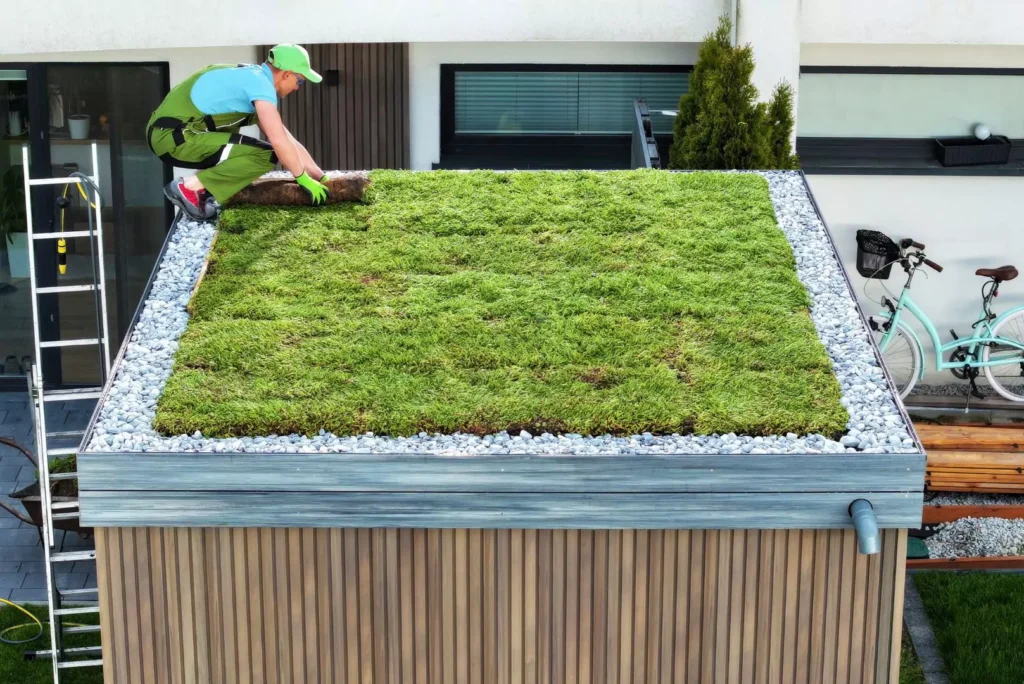
When is it Best to Choose EPDM?
EPDM generally works well for most flat roofs, but there are specific situations where considering this material as a roofing material will be an exceptionally good idea:
- Ballasted structures – EPDM has all key properties needed for non-integrated roof system. This material is highly resistant to mechanical damage, allowing it to be safely loaded with gravel, concrete slabs or installed photovoltaic panels;
- Green roofs – The long life of the material means that the garden will be able to grow peacefully for up to 60 years, without integrating in an insulation layer. Drainage of water from rainfall or watering is not a problem either, as EPDM is fully waterproof. For green roofs, it’s worth considering membranes with resistance to root overgrowth – it’s an additional cost, but it ensures that the material won’t be punctured by plant roots;
- Roofs with irregular shapes or numerous details – In this case, EPDM works well due to its easy and flexible installation. The membrane can be cut and shaped freely on site, ensuring that the sheets are easy to adapt to various obstacles such as manholes, corners, edges, etc. On top of this, manufacturers often offer ready-made flanges and cuffs, which further simplify the installation of EPDM in more complicated areas.
EPDM – Pros and Cons
Below we have compiled a clear list of the most important advantages and disadvantages of EPDM roof membrane.
Advantages
- Excellent water resistance – EPDM has a very good level of waterproofing and does not stand out in this regard in any way from its competitors, such as TPO or PVC – all of which provide 100% water resistance (when properly installed);
- Top-level weather resistance;
- Lifespan – With proper installation, EPDM can last up to 60 years;
- Fire resistance – This material is difficult to ignite and goes out as soon as the source of fire is removed;
- Versatility and ease of installation – EPDM finds its application in many different situations and the fastening method can be adjusted to suit the specific case;
- Eco-friendliness – It does not emit toxins and does not adversely affect rainwater;
- Very low dead weight – The material is very light and does not weigh down the roof structure.
Disadvantages
- High cost – EPDM is slightly more expensive than PVC and TPO;
- Black color – The material is usually black in color, which promotes the heating of the roof;
- Susceptibility to some kind of mechanical damage – EPDM can be easily punctured by sharp objects (e.g. falling branches);
- Various consequences from improper installation (a flaw universal to most roofing materials).
Summary
If you own a flat roof and want a solution that guarantees longevity and crack resistance, as well as being environmentally friendly, an EPDM membrane will be a great option for you to consider. It can last up to 60 years, does not emit toxins, and is perfect for unconventional roof shapes or applications.
Can EPDM roof be repaired?
As much as possible. Although restoring the original structure of the polymer is obviously not possible, roofing contractors successfully apply an additional layer of membrane in areas where leaks have appeared. Repairs are relatively inexpensive and simple.
Can EPDM roofing be painted?
Painting EPDM roofing membranes is possible and uses acrylic paint dedicated to painting rubber. In our experience, however, this is usually not a good idea. This is because you need to remember that the application of paint can affect the performance of your roof, for example, deteriorating its ability to transport water vapor.
Can EPDM be used on a pitched roof?
Yes, but it is not the best possible solution. While rubber roofing membranes are suitable for installation on sloped roofs, they are definitely not the optimal solution. EPDM is susceptible to damage, and at the same time does not show additional advantages, as is the case with its installation on low pitched or flat roofs. It is also worth noting that the installation of polymer membranes is much more difficult when the roof has an angle greater than 10 degrees (roof pitch 2/12 or more).
Can EPDM be installed in cold weather?
As much as possible, and this is one of its greatest advantages. Although any of the commonly used membranes perform better when installed in relatively high temperature conditions, the self-adhered EPDM roofing system can be laid at temperatures as low as 20 degrees fahrenheit (-7 degrees celsius). On the Internet you may come across information that installation is possible even at 10 degrees fahrenheit, but this is already highly risky. It is a good idea if you decide to reroof at temperatures above 40 degrees fahrenheit – this will positively affect the life of your roof.

